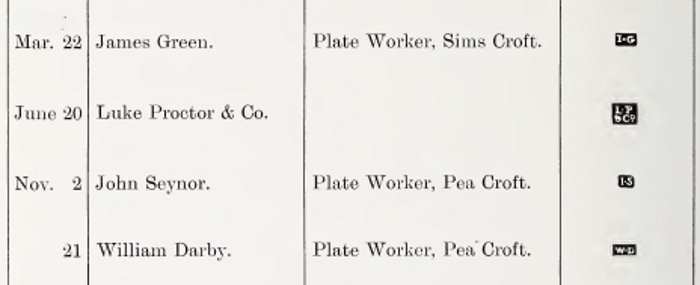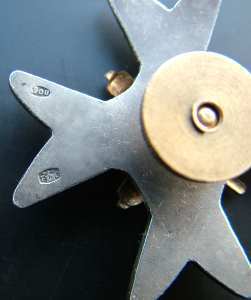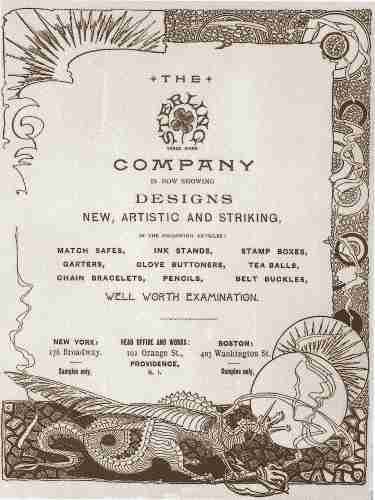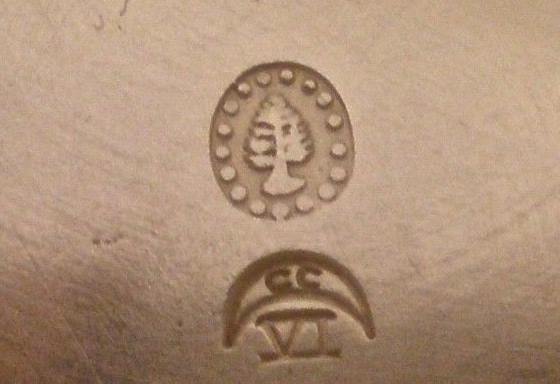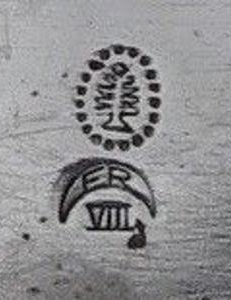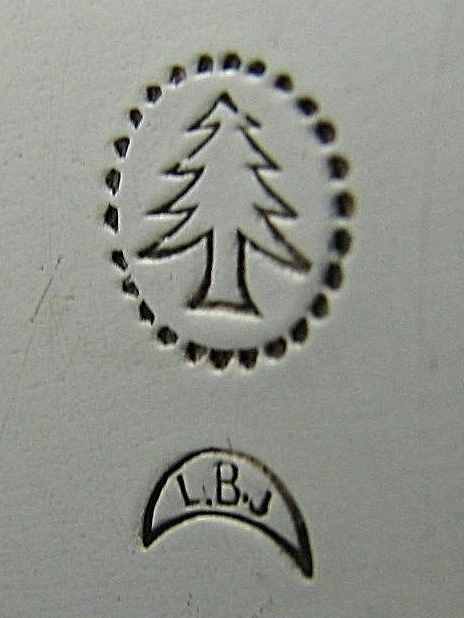YOUR GUIDE TO FEBRUARY NEWSLETTER:
articles
new members
members' window
mail to ASCAS
replies to questions
a page per month
a silversmith per month
a word per month
a book on my shelf
a crest per month
a year per month
contributors to this Newsletter
search engine
disclaimer and privacy policy
Joanna Paprocka-Gajek and David N. Nikogosyan present:
Warsaw Silver Plate Companies: III. Brothers Henneberg

In 1824 the French businessman Joseph Fraget moved from Paris to Warsaw and together with his brother Alfonse founded a factory to manufacture silver-plated objects. This foundry was the first of its kind not only in Warsaw but in the whole Eastern Europe and was active until 1939 [see References and Notes 1]. Second by importance the Warsaw silver plate factory Norblin and Co. (from 1883 Norblin & Co & Bros.Buch, from 1893 Norblin, Bros. Buch & T. Werner) was founded in 1831 and survived also until 1939. It was also founded by the French emigrant Vincent Norblin [see References and Notes 2,3]. The third renowned Warsaw silver plate foundry was created in 1856 and managed until 1907 by the German emigrant Julius Henneberg, his brother Wilhelm and his son Julian. This investigation is dedicated to the Bros. Henneberg silversmith foundry in Warsaw.....
click here

David N. Nikogosyan and Joanna Paprocka-Gajek present:
Marks used by Brothers Henneberg Company for silver-plated hollow ware and flatware

A fragment of the title page of Bros. Henneberg Catalogue, issued in c.1894 (in Russian and Polish).
click here

Welcome to new ASCAS members:
Sabrina Campbell - USA
Florin Dumitrescu - Romania
Lara Hart - USA
Dong Meng - China
Nenad N. Petrovic - USA
Elvira ter Horst - The Netherlands
Robin Holmes writes:
...The marks on this pair of asparagus tongs seem to me to Polish but I fail to identify exactly-
Please help!
Robin Holmes
Geoffrey Teece writes:
...Despite an in depth internet search I have drawn a blank in ascertaining the maker of a particular Polish Regimental Badge from around 1946.
The item appears to have a Belgian silver quality mark, A900 in a cartouche and a maker mark with the initials F C appearing either side of a logo in another cartouche.
Basically this communication is Help please!
Best wishes,
Geoffrey Teece
The maker is ETABL.FISCH 59 Avenue E. Rostand Bruxelles.
Giorgio Busetto
David Boddy writes:
...I am attaching some pics of hallmarks on a pair of silver Old English pattern tablespoons I purchased recently at an antique fair in Johannesburg.
I know some countries did stamp the year of manufacture on their silver and these silver spoons seem to date to 1831.
As you can see there are 5 marks on each spoon and I would be most grateful if you could let me know the origin of these marks and what country they were assayed in.
Kind wishes
David Boddy
In this column we presents a page obtained from makers'
brochures, books, auction catalogs, advertising or whatever
other printed paper, related to silver, that may be of interest
for ASCAS members.
The images will be published at a "low resolution" level and for
private and personal use only.
This column is published under the kind permission of Giorgio
Busetto's website
OTHER SILVER ADVERTISEMENTS

This month ASCAS presents an 1888 advertisement of
THE STERLING COMPANY
The firm was established in 1878 in Providence, Rhode Island, as H. Howard & Co for the manufacture of plated jewelry.
The firm changed to Howard & Scherrieble (1879) and Howard & Son (1884 - 1889).
The Sterling & Co was a new department established in 1886 for the manufacture of sterling silverware.
In 1891 the electroplated goods branch was sold to Parks Bros. & Rogers and the name of the corporation, now devoted only to the silver business, was altered to Howard Sterling Co.
In 1901 the firm went out of business and some of the patterns and dies were sold to Roger Williams Silver Company and others.
In this column
we present marks, information and history of silversmiths and
silver manufacturers.
This column is published under the kind permission of Giorgio
Busetto's website

TUTTLE SILVERSMITHS
The firm's origin in 1890 when Boston silversmith Timothy Tuttle was commissioned to copy old English silver. Tuttle dated his original production in the English custom with the crest of the reigning monarch.
In 1915 the company was listed as Tuttle Silver Co and by 1922 it was incorporated.
During the term of office of President Calvin Coolidge Tuttle adopted this custom marking each piece with a crescent and the initials of the incumbent President of the United States...
MORE...
Usually in this column we
present images and descriptions of Crests and Mottoes of British,
Irish and Scottish families as engraved on silver items.
This month Maurice Meslans presents the crest and coat of arms of an American family

FAMILY CRESTS: LIST OF NAMES
ILLUSTRATED DIRECTORY OF FAMILY CRESTS
BRUEN

It is very difficult to associate with certainty an individual with a coat of arms let alone a crest. It is always a bit exciting to do so.
This is a coat of arms found on a recently purchased set of flatware made in Paris c. 1819. To some degree the crest is more important. The motto "fides scrutum" or "faith shields" in Latin was a big help to identifying it.
The best I can describe the arms would be: in quarter 1 and 4 an eagle in sable displayed and in quarters 2 and 3 in a field of gold a chevron of sable and three leopard faces.
The crest is a fisherman holding a staff in his right hand and a net over his left shoulder. As it turns out the description is fairly close to one found on the internet, with the exception that someone described, I believe in error, the leopard faces as lion faces. As it turns out essentially the same arms were shown on a bookplate belonging to a Matthias Bruen, the father a wealthy man of Newark, NJ and the son a minister in New York, NY.
The family was originally from Stapleford and had a legitimate coat of arms. They arrived with the Puritans in America over the years the family coat of arms changed with marriages.
While the one shown could have been used by either father or son, there is no doubt who purchased the silver. Matthias Bruen Jr. was a minister at the American Chapel of the Oratoire in Paris in 1819.
Maurice Meslans
DISCLAIMER AND PRIVACY POLICY
ASCAS is a community of people having a common
interest in antique silver.
It is a non-profit association without commercial links.
Membership is open to whomever has a true interest in
this subject matter.
ASCAS has no real property and no fees are requested nor
accepted from members.
ASCAS keeps in touch with its members only through
periodical newsletters, e-mails and web-site updating
and ignores and is not responsible for any other
activity pursued by its members.
Likewise, ASCAS is not responsible for opinions,
evaluation and images displayed, and in any form
published or supplied for publication, by its members
who, in any case, maintain the property of their works
and assure the respect of national and international
legislation about Intellectual Property.
ASCAS does not have the full addresses of its members (only
town, country and e-mail address are requested for
membership).
ASCAS handles and protects with care its members' e-mail
addresses, will not disclose the addresses to third
parties, will use this information only to reply to
requests received from members and for communications
strictly related to its activity.
These rules are expressly accepted by submitting the
membership request.
|
|


